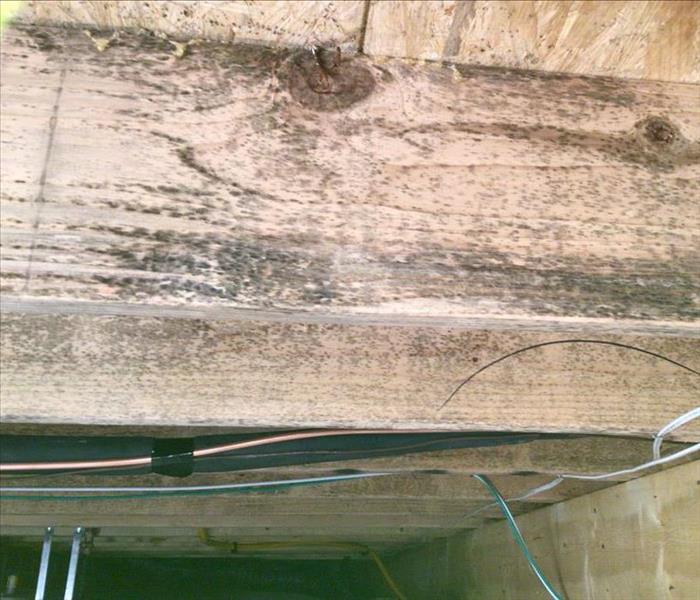Mold in New Construction: Prevention and Early Intervention
3/13/2024 (Permalink)
 New construction sites may seem immune to mold, but they can be susceptible to mold growth if proper precautions are not taken.
New construction sites may seem immune to mold, but they can be susceptible to mold growth if proper precautions are not taken.
New construction sites may seem immune to mold, but they can be susceptible to mold growth if proper precautions are not taken. Mold can cause structural damage and lead to expensive remediation efforts if left unchecked. In this blog, we will explore how mold can show up on new construction sites, the signs to look for, early intervention steps to remediate mold, and methods to prevent further mold development on the site.
How Mold Shows Up on New Construction Sites
Mold can find its way onto new construction sites due to a variety of factors, such as improper drying of building materials, excessive moisture, or water leaks during construction. Here are some common areas where mold may appear:
- Building Materials: If construction materials are exposed to wet or humid conditions for an extended period, mold can develop on surfaces like wood, drywall, or insulation.
- Basements or Foundations: Areas below ground level, such as basements or foundations, are more likely to have higher moisture levels. If proper waterproofing measures are not implemented, mold can grow on the concrete or other building materials.
- Plumbing and HVAC Systems: Leaks or condensation from plumbing or HVAC systems can create a conducive environment for mold growth behind walls, ceilings, or in crawl spaces.
Early Intervention to Remediate Mold
If mold is detected on a new construction site, prompt action is crucial to prevent further damage. Here are the steps for early intervention and remediation:
- Assess the Scope: Determine the extent of the mold growth and identify the affected areas. This assessment will guide the remediation process.
- Isolate the Affected Area: To prevent the spread of mold spores, isolate the affected area by sealing it off with plastic sheeting. This containment minimizes the risk of cross-contamination.
- Remove Mold-Infested Materials: Any mold-infested materials, such as drywall or insulation, should be carefully removed and disposed of in a manner that avoids spreading mold spores.
- Thoroughly Clean the Area: Clean all surfaces using appropriate mold-remediating products. This step helps eliminate any remaining mold spores and ensures the area is properly sanitized.
- Dry and Dehumidify: Implement proper drying techniques to eliminate excess moisture from the area. Utilize dehumidifiers and fans to aid in drying building materials.
- Monitor and Inspect: Continuously monitor the construction site for any signs of recurring mold growth. Regular inspections will help detect and address any potential issues before they escalate.
Preventing Further Mold Development on the Site
To prevent future mold growth on a new construction site, it is essential to implement preventive measures. Here are some key steps to consider:
- Proper Moisture Control: Ensure that the construction site is properly protected from rain, and implement moisture control measures like covering materials and using dehumidifiers.
- Effective Ventilation: Adequate ventilation throughout the construction site helps reduce moisture buildup. Install and maintain fans or ventilation systems to promote air circulation.
- Regular Inspections: Conduct regular inspections to identify any signs of moisture intrusion, leaks, or water damage. Address these issues promptly to prevent mold growth.
- Thorough Quality Control: Implement strict quality control measures throughout the construction process. This includes inspecting materials for signs of moisture damage before installation and addressing any issues immediately.
- Professional Mold Remediation: If mold reappears or becomes a recurring issue, consult a professional mold remediation company like SERVPRO® for thorough assessment and remediation. Their experts can provide recommendations to prevent further mold damage.
By taking proactive steps and addressing mold issues promptly, you can prevent further mold development and ensure the success of your new construction project.
Mold on your Construction Site
Mold growth on new construction sites can lead to structural damage and compromise the success of the project. Preventing mold from developing and taking early intervention steps are essential to avoid further damage. Regular inspections, prompt remediation, effective moisture control, and professional assistance when needed will help prevent future mold damage on new construction sites. Invest in mold prevention strategies to ensure the long-term success of your construction project.


 24/7 Emergency Service
24/7 Emergency Service